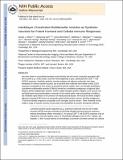Interbilayer-crosslinked multilamellar vesicles as synthetic vaccines for potent humoral and cellular immune responses
Author(s)
Moon, James J.; Suh, Heikyung; Bershteyn, Anna; Stephan, Matthias T.; Liu, Haipeng; Huang, Bonnie; Sohail, Mashaal; Luo, Samantha; Ho Um, Soong; Khant, Htet; Goodwin, Jessica T.; Ramos, Jenelyn; Chiu, Wah; Irvine, Darrell J; ... Show more Show less
DownloadIrvine_Interbilayer-crosslinked.pdf (3.113Mb)
PUBLISHER_POLICY
Publisher Policy
Article is made available in accordance with the publisher's policy and may be subject to US copyright law. Please refer to the publisher's site for terms of use.
Terms of use
Metadata
Show full item recordAbstract
Vaccines based on recombinant proteins avoid the toxicity and antivector immunity associated with live vaccine (for example, viral) vectors, but their immunogenicity is poor, particularly for CD8+ T-cell responses. Synthetic particles carrying antigens and adjuvant molecules have been developed to enhance subunit vaccines, but in general these materials have failed to elicit CD8+ T-cell responses comparable to those for live vectors in preclinical animal models. Here, we describe interbilayer-crosslinked multilamellar vesicles formed by crosslinking headgroups of adjacent lipid bilayers within multilamellar vesicles. Interbilayer-crosslinked vesicles stably entrapped protein antigens in the vesicle core and lipid-based immunostimulatory molecules in the vesicle walls under extracellular conditions, but exhibited rapid release in the presence of endolysosomal lipases. We found that these antigen/adjuvant-carrying vesicles form an extremely potent whole-protein vaccine, eliciting endogenous T-cell and antibody responses comparable to those for the strongest vaccine vectors. These materials should enable a range of subunit vaccines and provide new possibilities for therapeutic protein delivery.
Description
available in PMC 2011 September 1
Date issued
2011-02Department
Massachusetts Institute of Technology. Department of Biological Engineering; Massachusetts Institute of Technology. Department of Materials Science and Engineering; Ragon Institute of MGH, MIT and Harvard; Koch Institute for Integrative Cancer Research at MITJournal
Nature Materials
Publisher
Nature Publishing Group
Citation
Moon, James J., Heikyung Suh, Anna Bershteyn, Matthias T. Stephan, Haipeng Liu, Bonnie Huang, Mashaal Sohail, et al. “Interbilayer-crosslinked multilamellar vesicles as synthetic vaccines for potent humoral and cellular immune responses.” Nature Materials 10, no. 3 (February 20, 2011): 243-251.
Version: Author's final manuscript
ISSN
1476-1122
1476-4660